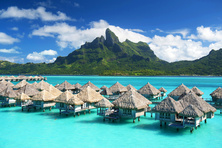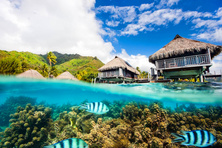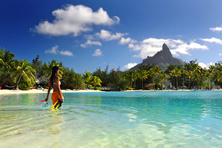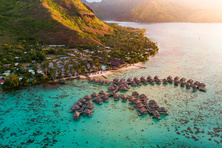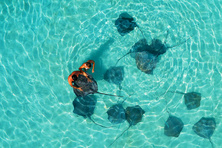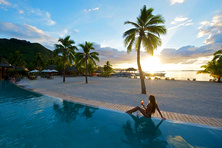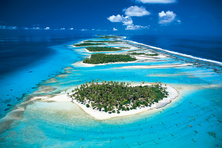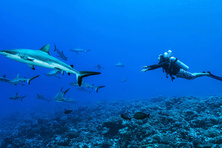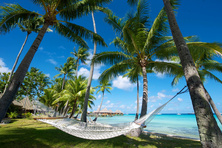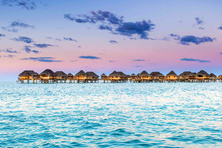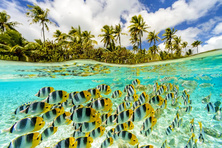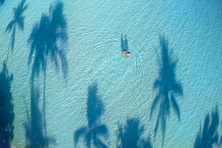French Polynesia
- Currency: CFP franc
- Time: UTC-10, UTC-9:30, UTC-9
- Languages: French
- Religions: Christianity (Catholicism, Protestantism)
- Sections: Get in Visa Customs Cuisine Money Details of interest Popular resorts
French Polynesia is an oversea country of France which consists of several archipelagos: the Tuamotu Archipelago, the Tubuai Islands, Marquesas Islands, and the Society Islands. On the west, French Polynesia borders the waters of the Cook Islands; on the north-west it borders with Kiribati, on the south-east with Pitcairn Island and on the east, north, and south it borders the neutral waters of the Pacific Ocean. The administrative centre is the city of Papeete on the Tahiti Island.
The climate of the French Polynesia is tropical in the main part of the territory and sub-equatorial on the north. There are two seasons in French Polynesia: dry (from June to October) and wet (from November to May). The average annual temperature is +26°C. The best time for visiting French Polynesia is from May to October.
The majority of the population (about 80%) are the Christians, the Catholics and the Protestants. The official languages are French and Tahitian.
The islands are a true paradise for those who love beach resorts. The coasts of Tahiti, Bora Bora, Nuku Hiva, and Tikehau will delight even the pickiest tourists.
The waters of Tahiti are rich in coral reefs and many divers come here. There are many areas for snorkelling and underwater hunting near the Rangiroa Island. And the Moorea Island is the best place for windsurfing and kitesurfing.
The Manihi Island which comprises the Tuamotu Archipelago will attract the fans of out-of-town holidays. The Manihi lagoon is the centre of entertainments. A trip and an excursion to the Kwan Collections Partners is offered to the tourists. This is the largest black pearl farm in the world. There are many water activities here such as unforgettable diving, deep underwater fishing, surfing, yachting, and skate feeding.
The unique ecological system of the coral reefs on the Fakarava Atoll is a reserve under UNESCO protection. The Fakarava Lagoon is the favourite place of the divers where one can see the population of skates, a tiger shark or a hammer-head shark. In the Tetemanu Village, the tourists will see an ancient Catholic cathedral or can visit the rori farm (edible sea cumber).
Bora Bora can offer something for all the tourists. You can go shopping here, take a boat trip, try snorkelling, diving or just take a walk and enjoy the exotic nature of Bora Bora.
Get in
The only way to get to French Polynesia is a flight.
There are no direct flights to French Polynesia from CIS and European countries.
The CIS tourists should choose a route with a stop in Tokyo. From the Japanese capital city, there is a direct flight to Tahiti offered by Air Tahiti Nui. From Moscow, one can take a transit flight with a transfer in Paris or Los Angeles with Air Tahiti Nui or Qantas.
From Kiev, the tourists can get to Papeete with a stop in London and Los Angeles (American Airlines).
Visa
The tourists from CIS and EU countries must obtain a visa to travel to French Polynesia. One should apply to the French Embassy.
Usual short-stay Schengen visa will not be valid on the islands as French Polynesia is not a member of the Schengen Area. If the tourists had a valid multiple-stay Schengen visa or a French temporary residence permit, a visa is not required.
Customs
According to the Customs legislation, one can import foreign and national currency without any limitations. If the tourists bring in 7.660 Euro and more, they must indicated this sum in the declaration form.
It is allowed to import the following goods duty-free:
- alcohol and tobacco;
- tea and coffee (100 g);
- perfume (250 ml).
It is prohibited to import foods of plant and particularly of animal origin and faux pearls.
The tourists are allowed to export black pearls provided that they have a sales receipt.
Cuisine
French Polynesia is a good place for the foodies as there are Italian, Vietnamese, Chinese, French and unique Polynesian cuisines. The Polynesian cuisine is so unusual because it combines the European cooking traditions and the old recipes of the sea tribes.
The traditional cuisine is known for its exquisite fish and seafood dishes. The travellers can try marinated oysters, mussels, and a roasted crab. Do not miss a chance to try the hallmark dish of French Polynesia Poisson cru (a salad with marinated and chopped fish with vegetables and coconut water dressing).
A pork with curry sauce and taro root, roasted chicken, beefsteaks, and miniature kebabs Shish will make your mouth water. Chinese ma’a tinito is an unusual combination of pork with Chinese leaves, pasta and beans.
Polynesian desserts deserve a special mention. You can treat yourself to air-dried or smoked sweet fruits and Po’e (taro root, banana, paw pudding with vanilla and coconut water).
The locals make alcoholic beverages from fruit juices but in the shops, you will find a great assortment of imported drinks. It will be difficult to try local alcoholic beverages.
Money
The official currency in French Polynesia is the French Pacific Franc (XPF) which also known as the French Polynesian Franc (CPF).
In circulation are:
- the bank notes from 500 to 10.000 francs;
- the coins from 1 to 100 francs.
The French Pacific Franc is pegged to Euro and 1 Euro is 119.331 XPF.
We recommend exchanging foreign currency at banks, in authorised exchange offices or in hotels. For currency exchange transactions, you will be charged 5% of the sum. During the week, the working hours of the banks on the islands are from 8.00 a.m. to 3.30 p.m.
One can pay with traveller’s checks and cards Visa, American Express, and MasterCard in the restaurants, hotels, and touristic areas in Tahiti and Bora Bora. In other places, the cards are not accepted.
The criminal level is low in French Polynesia so the holidays in this paradise are safe.
Details of interest
Customs and traditions in French Polynesia
There are no strict rules to observe in French Polynesia.
However, the tourists should be aware that on the islands Matriarchy is accepted. Women have always played the main role both in the family and in society.
Sightseeing in French Polynesia
Each of the islands is an individual sight but, of course, it is impossible to visit all the islands during your holidays. Triplook made a list of the most popular places in French Polynesia.
- The Literary and Historical Museum in Tahiti will tell the tourists about the history and the culture of the islands, about the life of great writers and painters who lived and worked here. The Paul Gauguin Museum in Papeete offers to have a look at personal belongings of the artists, his works and memoirs.
- A trip to Papeete will delight the tourists. In the only Black Pearl Museum in the world, one can see the exposition and buy unique pearl jewellry. The bright, colourful and noisy Municipal Market offers exotic fruits, souvenirs, and clothes.
- The Tiki Village Cultural Center was founded by a French Olivier Brisac. At first, this place was occupied by a dancing group and later craftsmen followed them and built their workshops.
- The Tubuai Islands is the place where you can see an abandoned coffee factory.
- On the Tahaa Islands, the travellers can visit the vanilla plantations.
- The Ua Pou Marquesa Islands are famous for their touchstone columns.
- Hua Hin is the most mysterious island in French Polynesia which still preserved untouched lush tropical forests. Near the Maeva Village, the archaeologists found the biggest meeting place of the Aborigines from the Maori tribe.
- The Bora Bora Lagoonarium is a park where anyone can see the underwater habitats. The travellers will see bright-colored tropical fish, skates, morays, dolphins, sea turtles, and reef sharks.
- The Moorea Dolphin centre offers interesting entertaining programs and a swim with the dolphins.
Souvenirs in French Polynesia
The most popular souvenir from French Polynesia is pearls. You can buy it in Papeete, in Tahiti jewellery stores or on the pearl farm.
In the Tiki village and on the Ravavae island, the tourists usually buy crafts made of sandalwood (figurines and beautifully carved everyday objects).
On the Rurutu islands, anyone can buy screw-pine souvenirs and gifts such as textile and rugs.
The most adventurous travellers bring a gift from French Polynesia literally on themselves in the form of tattoos.










